#Elmisaurus
Explore tagged Tumblr posts
Text
God damn it i hate you for making me start thinking. YOU KNOW WHO YOU ARE
But
May i present to the class:
What dinosaurs i think each mercenary could take down in hand to hand combat. (Note: i see this as their limits, they will get very injured but other wise be able to manage their own)
Scout: a Gallimimus
He is not particularly the strongest mercenary, but he makes up for that with speed. I believe with a well placed hit, Scout can very nicely take down a gallimimus.
Soldier: a Utahraptor
Ok hold on! Yes, the Utahraptor is bigger than him, however this man is a lead poisoned, american made fighting machine. Will he get bloody? Yes. But will he manage? Absofuckinglutely
Pyro: a Elmisaurus
I am ready to take heat for this. I do not see Pyro being good in hand to hand combat. They are an amazing arsonist! But strip away their axe, flamethrower, and all that and it’s just… pyro. Elmisaurus is still a tough dinosaur! Definitely not a weaklings choice, but not the strongest.
Demoman: an Adasaurus
@caillousweave I‘m sorry. He is strong, but not soldier strong. I don’t have much more to say on this one.
Heavy: i am saving for last :3
Engineer: a Latenivenatrix
I believe in him. He’s strong and stocky, plus Texas yeehaw. Again, it will be ROUGH, but he will manage
Medic: an Oviraptor.
Guy he got his shit rocked by a human man, he can NOT be in the ring with a big dinosaur. Sue me, kill me, idc 💙
Sniper: - a pachycephalosaurus
Based on my convo with a very delusional person who believes they can fight a Kapro (totally not targetted 💙) I believe Sniper could reasonably fight a Pachy. Again, not much to say on this
Spy- a velociraptor
COMPSOGNATHUS, THAT WEAK LITTLE BABY MAN WILL GET WRECKED BY A COMPY 🙄🙄🙄. Putting my hatred aside, he, like his son, is not exactly muscley like the likes of Soldier and Demo and Heavy. So, i believe he could crawl his nasty, puny, ugly rat ass out of this fight.
Heavy- a Centrosaurus
Big man needs a big challenge, and boy is this baby big. Not Triceratops big, but i believed Trike was too much. I can see Heavy grabbing it by the horn as leverage.
Thank you for coming to my TEDtalk
#crow squaking#dinosaurs#tf2#team fortress 2#tf2 scout#tf2 soldier#tf2 pyro#tf2 demoman#tf2 heavy#tf2 engineer#tf2 medic#tf2 sniper#tf2 spy#fighting dinosaurs#gallimimus#utahraptor#Elmisaurus#adasaurus#Latenivenatrix#oviraptor#pachycephalosaurus#velociraptor#centrosaurus#ted talks#thank you for coming to my ted talk
26 notes
·
View notes
Text

Originally known only from a foot, with scarce remains found since, Elmisaurus rarus means “Rare Foot Sole Lizard.” Even today, Elmisaurus fossils are highly fragmentary, as are most Caenagnathid remains, and consist mostly of foot and hand bones. However, if the fossils of Nomingia gobiensis can actually be attributed to Elmisaurus, which they may be, we might have a bigger picture of the animal. Elmisaurus has been the subject of but one study so far, where 23 foot bones from various specimens were studied for signs of stress fracture, and none were found. This animal was probably lightly built and not using its feet for strenuous activities. Rather, like other oviraptorosaurs, it would have relied on a sharp beak and strong bite force, lending to either herbivory of tough plant material or omnivory of both plants and small creatures.

Found in Late Cretaceous Mongolia, Elmisaurus rarus would have lived in the arid canyons of the Nemegt Formation. This environment was not entirely desert like the older Barun Goyot and Djadochta Formations, but also filled with thickly wooded forests of tall conifer trees and shallow lakes. It would have shared this environment with other oviraptorosaurs like Rinchenia, Nemegtomaia, and Avimimus. It would have also lived alongside troodontids like Tochisaurus and would have had to look out for Tyrannosaurs like Bagaraatan and Tarbosaurus. Hadrosaurs like Barsboldia and Saurolophus, the pachycephalosaurs Homalocephale and Prenocephale, sauropods like Nemegtosaurus, and the crocodylomorph Paralligator also lived here, as well as turtles, frogs, and small mammals.

If Nomingia is actually Elmisaurus, then it would have also lived alongside ornithomimosaurs like Anserimimus, Gallimimus, and Deinocheirus, the dromaeosaur Adasaurus, the bird Brodavis, alvarezsaurs like Mononykus, troodontids like Zanabazar, and Therizinosaurus in the Bügiin Tsav locality of the Nemegt Formation.


This art may be used for educational purposes, with credit, but please contact me first for permission before using my art. I would like to know where and how it is being used. If you don’t have something to add that was not already addressed in this caption, please do not repost this art. Thank you!
#my art#Elmisaurus rarus#Elmisaurus#caenagnathid#oviraptorosaurs#theropods#saurischians#dinosaurs#archosaurs#archosauromorphs#reptiles#Nemegt Formation#Late Cretaceous#Mongolia
13 notes
·
View notes
Text
Updated Eoneophron Skeletal
UPDATED Eoneophron infernalis skeletal
changes made: - increased width of bones (i didnt account enough for taphonomic distortion) - updated posture to be more balanced - changed back of crest to be more in line with Elmisaurus - fixed skin colour on human silhouette - added metatarsal V
If you want to see the original to compare, you can click here to see it
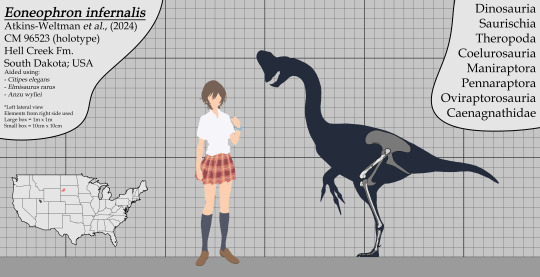
#paleoart#paleontology#digital art#artists on tumblr#digital artwork#palaeoart#digital illustration#sciart#id in alt text#dinosaur#Caenagnathidae#Eoneophron#Eoneophron infernalis#skeletal#scientific diagram#scicomm#science communication#updated skeletal#Kase Yamato#asagao to kase san
38 notes
·
View notes
Text

"Leaping Hell Chickens"
The newly discovered Caenagnathid Oviraptor-line dinosaur called Eoneophron infernalis (Dawn Neophron of hell). This emu sized theropod lived in the upper Cretaceous Hell Creek formation in South Dakota.
It was described as a new species from remains that were previously attributed to another Caenagnathid species called Anzu wyliei. The paper that described it, Atkins-Weltman et al. 2024, recovered it as closely related not to Anzu but another Caenagnathid called Elmisaurus.
#artists on tumblr#paleoblr#paleoart#traditional drawing#paleomedia#dinosaurs#dinosaur#oviraptor#hell creek formation#cretaceous#caenagnathid#eoneophron#homage#charles r knight reference
36 notes
·
View notes
Text

Elmisaurus
Elmisaurus — вимерлий рід динозаврів-тероподів з родини Caenagnathidae, відомий з формації Немегт (Монголія), що датується пізньою крейдою. Тварина описана лише за фрагментарними рештками.
Повний текст на сайті "Вимерлий світ":
https://extinctworld.in.ua/elmisaurus/
#elmisaurus#dinosaur#theropod#cretaceous#dinosaurs#paleoart#late cretaceous#science#cretaceous period#mongolia#caenagnathidae#paleontology#prehistory#extinct animals#scientific illustration#art#animals#prehistoric#палеоарт#палеонтологія#вимерлі тварини#доісторичні тварини#ukrainian#ukraine#україна#тварини#tumblr#українська мова#наука#scientific article
12 notes
·
View notes
Photo

Day 8: Elmisaurus Elmisaurus rarus is an caenagnathid dinosaur (the latter is closely resemble to oviraptoridae) with displaying tail feathers. #Dinovember #Dinovember2022 #paleoart #artistoninstagram #myart #elmisaurus #elmisaurusrarus #caenagnathidae #caenagnathoidea #oviraptorosauria #pennaraptora #maniraptora #theropoda #dinosauria #feathereddinosaur #sketchbook https://www.instagram.com/p/CktOHsMruGp/?igshid=NGJjMDIxMWI=
#dinovember#dinovember2022#paleoart#artistoninstagram#myart#elmisaurus#elmisaurusrarus#caenagnathidae#caenagnathoidea#oviraptorosauria#pennaraptora#maniraptora#theropoda#dinosauria#feathereddinosaur#sketchbook
2 notes
·
View notes
Photo

5/8/22 Elmisaurus
#daily dino#dinosaur#dinosaurs#dinosaur art#my art#paleoart#theropod#oviraptor#i think?#species: elmisaurus#i did duck colors#red breasted merganser duck#oviraptosauria are good mothers not egg theives#happy mothers day
157 notes
·
View notes
Text
Who is flashiest tailed birb group??? vote now on phones!!!
#palaeoblr#dinosaurs#poll#raptors#birds#I know dromaeosaurs will probably win but I can dream and hope right?#chickenparrots#anzu#velociraptor#stenonychosaurus#anchiornis#archaeopteryx#confuciusornis#yi
99 notes
·
View notes
Photo

For International Women's Day, here are four dinosaurs described/discovered by women: Deinocheirus, Gallimimus, Elmisaurus and Prenocephale. All four were found on the Polish-Mongolian expeditions of the 60s and 70s, notable for being among the first fossil expeditions to have a strong female presence. Among the teams were Halszka Osmólska, Teresa Maryańska and Zofia Kielan-Jaworowska, who would become renowned for their work on the dinosaurs and other palaeofauna of Mongolia.
#international women's day#dinosaur#deinocheirus#gallimimus#oviraptorid#pachycephalosaur#paleontology#paleoart#scientific illustration#Illustration#fossils#women in science
58 notes
·
View notes
Note
Do oviraptorosaurs have raptorial second pedal digits as suggested by Gauthier?
Certainly not to the extent seen in dromaeosaurids (as Gauthier acknowledged), but an as-yet-unpublished study presented at SVP 2016 by Struble and Organ did find support for a potentially raptorial function of the foot in Elmisaurus.
2 notes
·
View notes
Text


Dinovember 2024 Day 16 - Deinocheirus
Boys Night
#paleoart#Deinocheirus#Elmisaurus#dinovember#dinosuars#Dinovember 2024#Dreambob's art#I'm sorry guys. I ran out of ideas so here's more gay dinos#it will happen again#Deinocherirus is based on Wild Muscovy Duck and the Elmisaurus is based on the great tit
27 notes
·
View notes
Text

Native to the Late Cretaceous Nemegt Formation, Rinchenia mongoliensis was originally classified as a new species of Oviraptor before it was determined to be distinct enough to warrant its own genus. More complete than the Oviraptor holotype, Rinchenia was about the same size as its cousin, but less robust and sporting a large, domed, more highly-developed crest. Like Corythoraptor and modern day cassowaries, Rinchenia likely used its tall crest for display, heat-dissipation, and to detect low-frequency sounds. Like Oviraptor, it was probably an omnivore, and may have even used its sound-detection ability to locate burrowing prey.


Rinchenia lived in the Altan Uul locality of the Upper or Middle Nemegt with other oviraptorosaurs like Elmisaurus and Gobiraptor. It would have shared this seasonally arid landscape, broken up by cliffs, ravines, conifer forests, and shallow duckweed-filled lakes with other theropods like the alvarezsaurid Mononykus, the giant hump-backed ornithomimosaur Deinocheirus, a variety of birds, and the apex predator, the tyrannosaur Tarbosaurus bataar. Aside from seeds and nuts, Rinchenia may have also preyed on small lizards, mammals, and frogs like Altanulia.


This art may be used for educational purposes, with credit, but please contact me first for permission before using my art. I would like to know where and how it is being used. If you don’t have something to add that was not already addressed in this caption, please do not repost this art. Thank you!
#Rinchenia mongoliensis#Rinchenia#oviraptorid#oviraptorosaurs#theropods#saurischians#archosaurs#archosauromorphs#reptiles#SaritaDrawsPalaeo#Nemegt Formation#Late Cretaceous#Mongolia
29 notes
·
View notes
Text
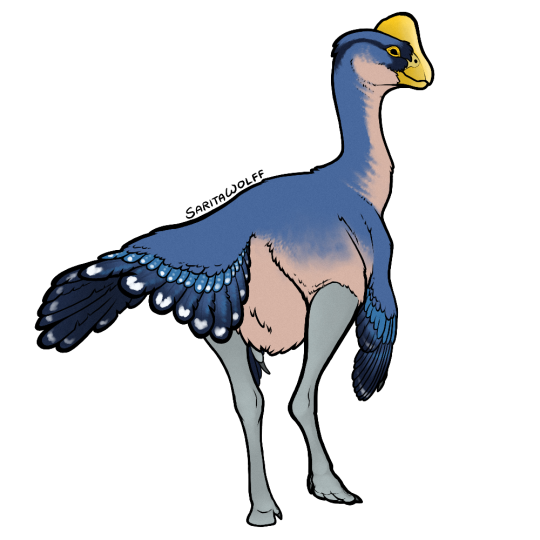
The gracile caenagnathids are notorious for fossilizing badly, and as such Nomingia gobiensis is only known from its spine, upper legs, and tail (which is honestly more than most other caenagnathids). However, its tail represents a significant discovery for oviraptorosaurs. Nomingia had five fused vertebrae at the tip of its tail, a structure similar to the pygostyle of birds, that would have supported a fan of tail feathers. When Nomingia was found in 1994 and described in 2000, this feature was thought to be unique to birds. And while we have evidence of tail fans in other oviraptorosaurs, pygostyles themselves are rare. It’s unknown why Nomingia would have needed this, as it was certainly too big for flying. Perhaps, like Khaan’s tail fan, it was used for display, and the structure would have allowed it to have a sturdier, larger, more “sexy” tail fan.

As of 2021, it has been suggested that Nomingia may actually be Elmisaurus, but further study is needed to confirm this. Since caenagnathid fossils tend to be so fragmentary, this may take some time.
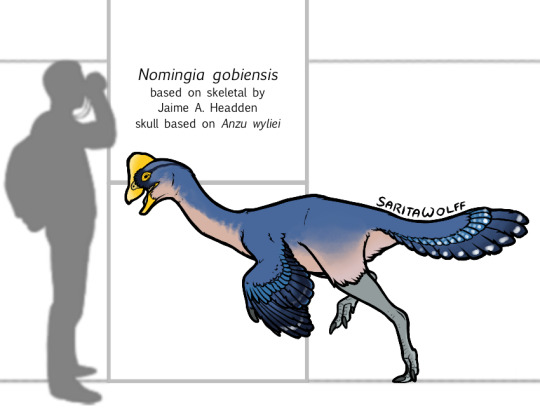
Hailing from the Bügiin Tsav and Nemegt localities of Mongolia’s Late Cretaceous Nemegt Formation, Nomingia would have lived alongside Avimimus nemegtensis in this seasonally arid environment characterized by cliffs, shallow lakes, and patches of conifer forests. If not Elmisaurus itself, it would have lived alongside it as well as the oviraptorids Nemegtomaia in the Nemegt and Oksoso in the Bügiin Tsav. There were of course other dinosaurs here, including Therizinosaurus, the troodontid Tochisaurus, the tyrannosaur Bagaraatan, the sauropod Nemegtosaurus, the hadrosaur Barsboldia, and the pachycephalosaur Homalocephale in the Nemegt.
In the Bügiin Tsav, Nomingia would have lived alongside the troodontid Zanabazar, the dromaeosaur Adasaurus, the bird Brodavis, the ornithomimosaurs Anserimimus and Deinocheirus, and the alvarezsaur Mononykus.
It would have come across Gallimimus, the hadrosaur Saurolophus, the pachycephalosaur Prenocephale, and the tyrannosaur Tarbosaurus in both localities. Crocodylomorphs like Paralligator, fish like Harenaichthys, and turtles could be found in the freshwater lakes.


This art may be used for educational purposes, with credit, but please contact me first for permission before using my art. I would like to know where and how it is being used. If you don’t have something to add that was not already addressed in this caption, please do not repost this art. Thank you!
#Nomingia gobiensis#Nomingia#caenagnathid#oviraptorosaurs#theropods#saurishcians#dinosaurs#archosaurs#archosauromorphs#reptiles#SaritaDrawsPalaeo#Nemegt Formation#Late Cretaceous#Mongolia
15 notes
·
View notes
Text

Avimimus nemegtensis, meaning “bird mimic”, was a very birdy oviraptorosaur and the type species of its own family Avimimidae, though some paleontologists put it within Caenognathidae. It had a long neck with a small head, though its braincase and eyes were comparatively large. Its legs were long and slender, and it was likely a fast runner. There are at least two species of Avimimus, A. portentosus (described in 1981) and A. nemegtensis (described in 2018 and depicted here). The tail was missing on the original Avimimus portentosus fossil, leading its describer to conclude that it must have lacked a tail in life! However, later specimens with caudal vertebrae and hips designed for carrying a long tail suggested otherwise. Due to its small to nonexistent teeth, it’s likely Avimimus was a herbivore and/or insectivore. Avimimus nemegtensis specimens have been found in a bonebed containing at least 10 individual adults, suggesting they may have flocked together or at least formed leks.


Once thought to have come from the Djadochta Formation, it is now considered more likely that both Avimimus species lived in the more recent Nemegt Formation. While currently in the middle of the Gobi Desert, the Nemegt Formation of Late Cretaceous Mongolia was once more lush and green, with forests of tall conifer trees, streams, and shallow lakes covered in duckweed and pondweed. Rivers carved out steep cliffs and canyons. This habitat supported a diverse amount of fauna, and Avimimus nemegtensis would have lived alongside a variety of dinosaurs, including true birds. While it was seemingly the only avimimid here (aside from A. portentosus), it lived alongside both oviraptorids like Nemegtomaia and caenognathids like Elmisaurus. Another “bird-mimic”, the speedy ornithomimosaur Gallimimus lived in the Nemegt as well. It would seem speed was necessary for these animals, as the tyrannosaur Tarbosaurus would have been the apex predator. If it could catch it, Avimimus would have been an easier meal for Tarbosaurus than the giant-clawed Therizinosaurus, the hadrosaurs Barsboldia and Saurolophus angustirostris, and the titanosaur Nemegtosaurus. But there was still a wealth of smaller prey Tarbosauruses both young and old could have pursued, such as the little pachycephalosaurs Homalocephale and Prenocephale, the troodontid Tochisaurus, and even the smaller tyrannosauroid Bagaraatan. Avimimus would have had to use its quick wits and quicker legs to stay alive.


This art may be used for educational purposes, with credit, but please contact me first for permission before using my art. I would like to know where and how it is being used. If you don’t have something to add that was not already addressed in this caption, please do not repost this art. Thank you!
#Avimimus nemegtensis#Avimimus#avimimid#oviraptorosaurs#theropods#saurishcians#dinosaurs#archosaurs#archosauromorphs#reptiles#Nemegt Formation#Late Cretaceous#Mongolia
10 notes
·
View notes
Text
Deinocheirus mirificus
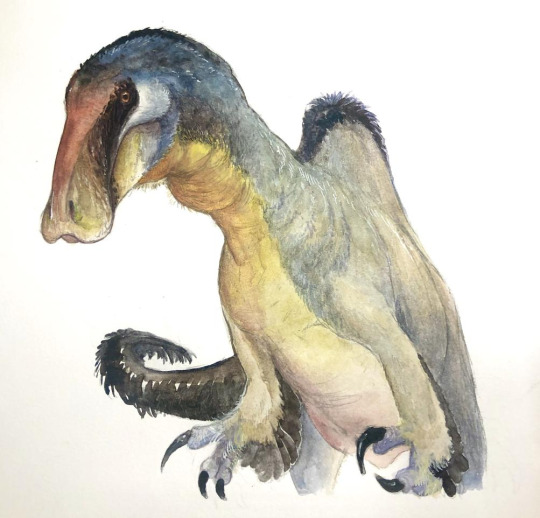
By Ripley Cook
Etymology: Horrible Hand
First Described By: Osmólska & Roniewicz, 1970
Classification: Dinosauromorpha, Dinosauriformes, Dracohors, Dinosauria, Saurischia, Eusaurischia, Theropoda, Neotheropoda, Averostra, Tetanurae, Orionides, Avetheropoda, Coelurosauria, Tyrannoraptora, Maniraptoromorpha, Maniraptoriformes, Ornithomimosauria, Ornithomimoidea, Deinocheiridae
Status: Extinct
Time and Place: 70 million years ago, in the Maastrichtian of the Late Cretaceous

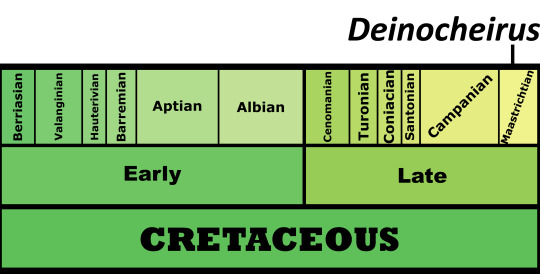
Deinocheirus is known from the Nemegt Formation of Ömnögovi, Mongolia
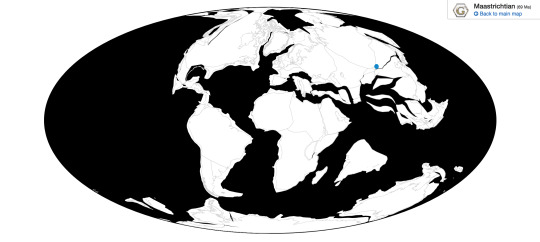
Physical Description: Deinocheirus is one of the absolute weirdest, fantastical, most surprising discoveries of the 2010s in paleontology, and the answer to a mystery older than most of the readers of this blog. Deinocheirus was originally known from two very long, distinctive arms - arms so long, that they could very easily engulf a person. In fact, many of the photographs of the fossil are of an individual standing in between the hands, in order to give scale to them. But these arms and hands gave very little in the way of information about what Deinocheirus looked like. Eventually, it was determined that Deinocheirus was an Ornithomimosaur - but the scale of the arms indicated it would be a ridiculously huge Ornithomimosaur.
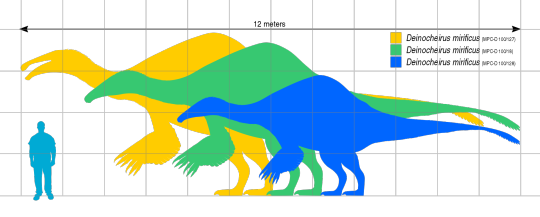
By Slate Weasel, in the Public Domain
And then, luckily, more fossils were found of it. To be sure, it was a ridiculously large Ornithomimosaur - in fact, given the fact that it was an Ornithomimosaur, a group of distinctively feathered dinosaurs, it is almost certainly one of the largest feathered animals known to date - but it was More than that by a large margin. It was probably around 11 meters long, weighing up to 6.4 tonnes. It had some of the largest forelimbs known of any bipedal dinosaur - only rivaled by Therizinosaurs - and the arms in question are 2.4 meters long. Its skull, only one specimen of it having been found, is honestly weirdly duck-shaped. It was low and narrow, like other Ornithomimosaurs, but with a longer snout than its relatives. This snout was wide and shaped like a spatula - similar to the snouts of duck-billed dinosaurs and ducks alike. There weren’t any teeth in the jaws, which ended in a distinctive beak, and it was turned down, to make it look fairly massive and deep. When you get down to it, Deinocheirus had a ridiculously triangular head.
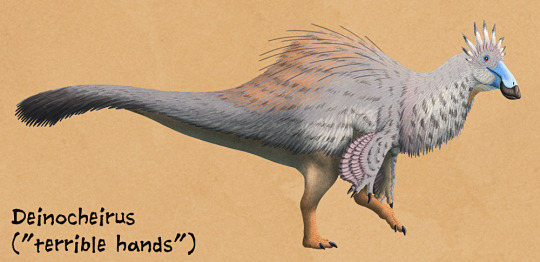
By Nix, CC BY-NC 4.0
As for the rest of the body, Deinocheirus had very long and narrow shoulder blades, connected to very pronounced and triangular shoulders. Weirdly enough, compared to the shoulders, Deinocheirus actually had smaller arms than its close relative Ornithomimus - ie, it had a smaller shoulder to arm ratio than its relatives. It had a U-shaped wishbone, which is fascinating since we don’t have the wishbone of other Ornithomimosaurs. Unlike other Ornithomimosaurs, it didn’t have pinched toe bones, so it wasn’t highly adapted for fast movement; it also had very blunt and broad foot claws like those of large Ornithischian dinosaurs. It may have been a bulky animal, but it was also quite narrow - with very tall, straight ribs. It had an S-curved neck, especially given the shape of the skull, which extended back into the oddly indeed shaped back. The spines on the back of Deinocheirus got progressively and progressively longer, until reaching lengths similar to those found on Spinosaurus - indicating that Deinocheirus had a sail or a hump, much like Spinosaurus did. There were interconnecting ligaments on the spines, strengthening it. That sail then lessened as it went down along the tail, until the tail had a very skinny appearance compared to the rest of the body. It had extremely lightweight air bones, through which the respiratory system ran. This also allowed it to be even more lightly built, which aided it in its large size. Interestingly enough, the tail ended in fused vertebrae, like those in Therizinosaurs, Oviraptors, and Birds - indicating it had a pygostyle!
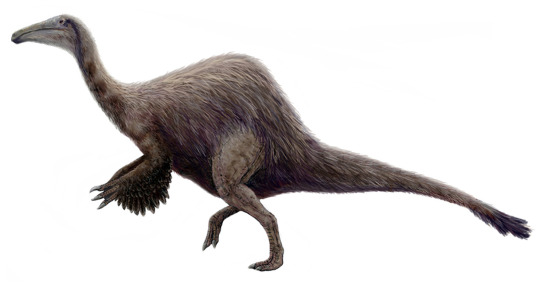
By Michael B. H., CC BY-SA 3.0
As for feathers, it would have probably been covered in a layer of fluff all over the body. Fancy, pennaceous feathers would have been present on the arms and the end of the tail - in fact, a tail fan would have been attached to that pygostyle and used in display. It may have also had display feathers on the back of the head or even the legs. However, that being said, its large size may indicate a decrease in fluff so that it could stay cool - while it is still most likely that it had distinctive and extensive feathers as in its close relatives, fossil evidence is needed to determine its exact integument situation.
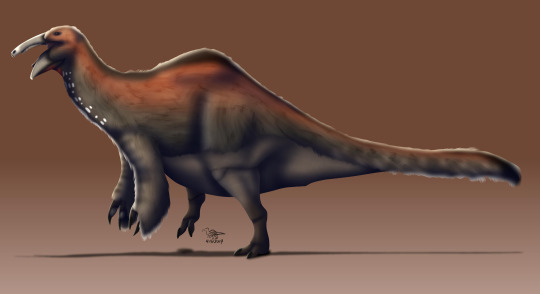
By Charles Nye
Diet: Deinocheirus was, distinctively, a large herbivore - specializing on water plants and other soft greens that could be shoveled up with that spoon beak.
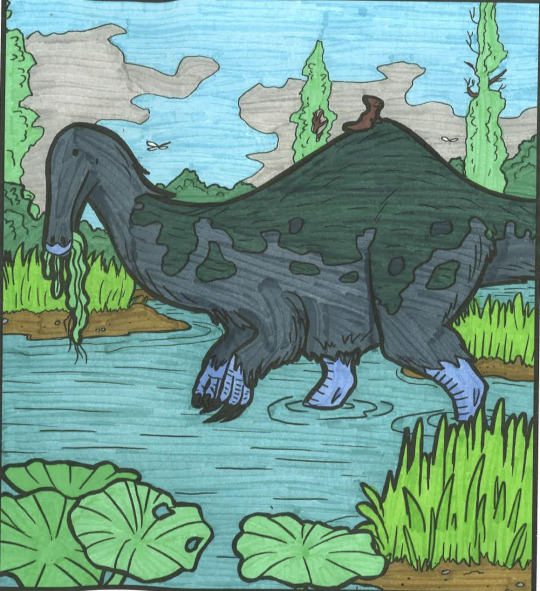
By Meig Dickson & Diane Remic
Behavior: Deinocheirus probably spent a good amount of time foraging at or near the water, gathering up water vegetation with its spatulate bill. It also utilized gastroliths - stones that were swallowed to grind up that wet and mushy vegetation in the stomach. This was important and helpful, since it couldn’t do much grinding without teeth in its mouth. It did have a very long and large tongue, which allowed it to pull up extensive amounts of plant material up from the ground. It would use the blunt and short claws of its hands in order to dig up plants from the water - and to decrease resistance as it sucked them up from the swamps.

By Rebecca Groom
Deinocheirus wasn’t a fast animal - the short and stocky legs meant that it moved slowly through its environment, and used its large size to protect itself against predators instead. It grew extremely rapidly, too, reaching large size before sexual maturity. Sadly, its giant size means that it didn’t have a very large brain compared to its body size - in fact, the ratio in question was more similar to that of sauropods than other theropods. That beings aid, it was similar in shape to birds and troodontids and other birdie theropods, indicating that it still had a decent sense of smell - which is fascinating as it had a good respiratory system as well. As a warm-blooded animal, however, it would have been very active; and as a dinosaur, it probably took care of its young in nests. It is uncertain whether or not it would have lived in social groups, but it certainly wouldn’t have been particularly isolated as an herbivore.

By José Carlos Cortés
Ecosystem: The Nemegt Formation was a wetland, filled with a wide variety of dinosaurs right before the end of the time of non-avian dinosaurs. The area was filled with large river channels, which created extensive shallow lakes, mudflats, and floodplains - like the modern Okavango Delta in Botswana. There were also thick coniferous forests surrounding the ecosystem, allowing for drier areas to be retreated to in addition to the swampy mess that was the bulk of the environment. Here, many plant-eaters specialized in feeding on water plants - in fact, I often joke that the Nemegt is the Land of Ducks. In addition to Deinocheirus, there were two other Ornithomimosaurs - Gallimimus and Anserimimus - both featuring duck-like beaks for feeding on water plants. Other ducks of the region include Saurolophus, which, as a duck-billed dinosaur, was especially adapted for feeding on soft plant material; and Teviornis, an early ACTUAL duck relative with the appropriate bill.
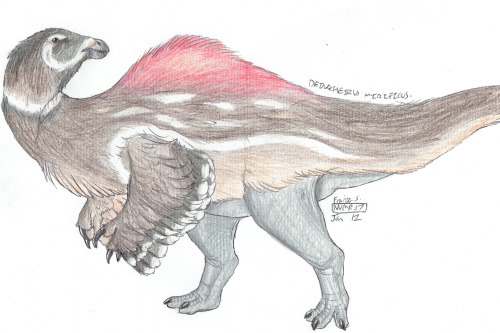
By Fraizer
This place also had other dinosaurs that weren’t ducks, of course. There was the large tyrannosaur, Tarbosaurus, which is known to have directly preyed upon Deinocheirus. There were troodontids too, like Tochisaurus, Zanabazar and Borogovia, which would have preyed upon the eggs and young of Gallimimus. There were a million different Oviraptorosaurs, making this also the ecosystem of the Chickenparrots - Avimimus, Elmisaurus, Conchoraptor, Nemegtomaia, Nomingia, and Rinchenia, were all present and feeding on the drier vegetation of the area. There was also the Hesperornithine Brodavis, one of the few freshwater species of Hesperornithines. There were other herbivores too, of course - Pachycephalosaurs like Homalocephale and Prenocephale, ankylosaurs such as Tarchia and Saichania, the titanosaur Nemegtosaurus, and the Therizinosaur Therizinosaurus - which probably all stuck to drier areas of the ecosystem than Deinocheirus. Tarbosaurus wasn’t the only Tyrannosaur, either - there was the smaller Alioramus which would have been more of a nuisance for baby Deinocheirus than the adults. And for other predators, there was the raptor Adasaurus, which may or may not have been a direct descendant of Velociraptor. As for non-dinosaurs, there was at least one Azdarchid, the small mammal Buginbaatar, and a variety of crocodilians that would have been non-negligible threats to young Deinocheirus. There were also plenty of turtles, which would have been a very noticeable part of the wider ecosystem.

By Scott Reid
Other: Deinocheirus is such a weird Ornithomimosaur, it gave its name to an entire group of them - these guys were slower than the Ornithomimids, and larger, but still had that general Ostrich-mimic shape. Instead of being lean and fast, they were large and slow. The discovery of the specimens of Deinocheirus that allowed us to actually learn what it looked like was a big one - since, prior to that point, Deinocheirus had been one of the most fascinating mysteries of dinosaur science, as all we had were two giant hands! Because of its large size, duck-like appearance, and above all, nightmare fodder in terms of past legend and current appearance, Deinocheirus has been fondly dubbed as Duck Satan for a makeshift common name.
~ By Meig Dickson
Sources Under the Cut
Arbour, V. M., Currie, P. J. and Badamgarav, D. (2014), The ankylosaurid dinosaurs of the Upper Cretaceous Baruungoyot and Nemegt formations of Mongolia. Zoological Journal of the Linnean Society, 172: 631–652.
Barret, P. M. 2005. The diet of Ostrich dinosaurs (Theropoda: Ornithomimosauria). Palaeontology 48 (2): 347 - 358.
Barsbold, R. (1983). "Carnivorous dinosaurs from the Cretaceous of Mongolia [in Russian]." Trudy, Sovmestnaâ Sovetsko−Mongol’skaâ paleontologičeskaâ èkspediciâ, 19: 1–120.
Bell, P.R., Currie, P.J., Lee, Y.N. 2012. Tyrannosaur feeding traces on Deinocheirus (Theropoda: ?Ornithomimosauia) remains from the Nemegt Formation (Late Cretaceous), Mongolia. Cretaceous Research 37: 186 - 190.
Chinzorig, T., Kobayashi, Y., Tsogtbaatar, K., Currie, P.J., Takasaki, R., Tanaka, T., Iijima, M., Barsbold, R. 2017. Ornithomimosaurs from the Nemegt Formation of Mongolia: manus morphological variation and diversity. Palaeogeography, Palaeoclimatology, Palaeoecology 494: 91 - 100.
Claessens, L. P. A., and M. A. Loewen. 2016. A redescription of Ornithomimus velox Marsh, 1890 (Dinosauria, Theropoda). Journal of Vertebrate Paleontology 36(1):e1034593:1-15
Fanti, F., Bell, P.R., Tighe, M., Milan, L.A., Dinelli, E. 2017. Geochemical fingerprinting as a tool for repatriating poached dinoaur fossils in Mongolia: A case study for the Nemegt Locality, Gobi Desert. Palaeogeography, Palaeoclimatology, Palaeoecology 494: 51 - 64.
Fowler DW, Woodward HN, Freedman EA, Larson PL, Horner JR (2011) Reanalysis of “Raptorex kriegsteini”: A Juvenile Tyrannosaurid Dinosaur from Mongolia. PLoS ONE 6(6): e21376.
Funston, G. F.; Mendonca, S. E.; Currie, P. J.; Barsbold, R. (2017). "Oviraptorosaur anatomy, diversity and ecology in the Nemegt Basin". Palaeogeography, Palaeoclimatology, Palaeoecology.
Gradzinski, R., J. Kazmierczak, J. Lefeld. 1968. Geographical and geological data form the Polish-Mongolian Palaeontological Expeditions. Palaeontologia Polonica 198: 33 - 82.
Holtz, T.R. 2014. Paleontology: Mystery of the horrible hands solved. Nature 515 (7526): 203 - 205.
Hurum, J. 2001. Lower jaw of Gallimimus bullatus. In Tanke, D. H., K. Carpenter, M. W. Skrepnick. Mesozoic Vertebrate Life. Bloomington: Indiana University Press. 34 - 41.
Jerzykiewicz, T., Russell, D.A. 1991. Late Mesozoic stratigraphy and vertebrates of the Gobi Basin. Cretaceous Reserch 12 (4): 346 - 377.
Kobayashi, Y., Barsbold, R. 2006. Ornithomimids from the Nemegt Formation of Mongolia. Journal of the Paleontological Society of Korea 22 (1): 195 - 207.
Kielan-Jaworowska, Z. 1969. Fossils from the Gobi desert. Science Journal 5(1):32-38
Kielan-Jaworowska, Z., R. Barsbold. 1972. Narrative of the Polish-Mongolian Palaeontological Expeditions 1967-1971. Palaeontologia Polonica 27: 5 - 136.
Kundrat, M., Lee, Y.N. First insights into the bone microstructure of Deinocheirus mirificus. 13th Annual Meeting of the European Association of Vertebrate Paleontologists: 25.
Lauters, P., Lee, Y.N., Barsbold, R., Currie, P.J., Kobayashi, Y., Escuille, F.O., Godefroit, P. 2014. The brain of Deinocheirus mirificus, a gigantic ornithomimosaurian dinosaur from the Cretaceous of Mongolia. Society of Vertebrate Paleontology Abstracts of Papers: 166.
Lee, Y.N., Barsbold, R., Currie, P.J., Kobayashi, Y., Lee, H.J. 2013. New specimens of Deinocherus mirificus from the Late Cretaceous of Mongolia. Society of Vertebrate Paleontology Abstracts of Papers: 161.
Lee, Y.N., Barsbold, R., Currie, P.J., Kobayashi, Y., Lee, H.J., Godefroit, P., Escuillie, F.O., Chinzorig, T. 2014. Resolving the long-standing enigmas of a giant ornithomimosaur Deinocheirus mirificus. Nature 515 (7526): 257 - 260.
Madsen, E. K. 2007. Beak morphology in extant birds with implications on beak morphology in Ornithomimids. Dek Matematisk-Naturvitenskapelige Fakultet - Thesis. 1 - 21.
Makovicky, P.J., Kobayashi, Y., Currie, P.J. 2004. Ornithomimosauria. In: Weishampel, D.B., Dodson, P., Osmolska, H. eds. The Dinosauria. University of California Press.
McFeeters, B., M. J. Ryan, C. Schroder-Adams and T. M. Cullen. 2016. A new ornithomimid theropod from the Dinosaur Park Formation of Alberta, Canada. Journal of Vertebrate Paleontology 36:e1221415:1-20
Middleton, K.M., Gatesy, S.M. 2000. Theropod forelimb design and evolution. Zoologicla Journal of the Linnean Society 128 (2): 160 - 172.
Mikhailov, K. E. 1991. Classification of fossil eggshells of amniotic vertebrates. Acta Palaeontologica Polonica 36(2):193-238
Molnar, R.E. 2001. Theropod Paleopathology: a Literature Survey. In: Tanke, D.H., Carpenter, K. eds. Mesozoic Vertebrate Life. Indiana University Press.
Newbrey, M. G., Donald B. Brinkman, Dale A. Winkler, Elizabeth A. Freedman, Andrew G. Neuman, Denver W. Fowler and Holly N. Woodward (2013). "Teleost centrum and jaw elements from the Upper Cretaceous Nemegt Formation (Campanian-Maastrichtian) of Mongolia and a re-identification of the fish centrum found with the theropod Raptorex kreigsteini". In Gloria Arratia; Hans-Peter Schultze; Mark V. H. Wilson (eds.). Mesozoic Fishes 5 – Global Diversity and Evolution. Verlag Dr. Friedrich Pfeil. pp. 291–303.
Norell, M. A., P. J. Makovicky, P. J. Currie. 2001. The Beaks of Ostrich Dinosaurs. Nature 412 (6850): 873 - 874.
Norell, M.A.; Makovicky, P.J.; Bever, G.S.; Balanoff, A.M.; Clark, J.M.; Barsbold, R.; Rowe, T. (2009). "A Review of the Mongolian Cretaceous Dinosaur Saurornithoides (Troodontidae: Theropoda)". American Museum Novitates. 3654: 63.
Novacek, M. 1996. Dinosaurs of the Flaming Cliffs. Anchor. Bantam Doubleday Dell Publishing Group Inc. New York, New York.
Osmolska, H., Roniewicz, E. 1970. Deinocheiridae, a new family of theropod dinosaurs. Palaeontologica Polonica 21: 5 - 19.
Paul, G.S. 1988. Predatory Dinosaurs of the World. Simon & Schuster.
Paul, G.S. 2012. The Princeton Field Guide to Dinosaurs. Princeton University Press.
Roy, B., Ryan, M.J., Currie, P.J., Koppelhus, E.B., Tsogtbaatar, K. 2018. Histological analysis of the gastralia of Deinocheirus mirificus from the Nemegt Formation of Mongolia. 6th Annual Meeting Canadian Society of Vertebate Paleontology.
Rozhdestvensky, A.K. 1970. Giant claws of enigmatic Mesozoic reptiles. Paleontologicheskii Zhurnal 1970 (1): 117 - 125.
Senter, P., Robins, J.H. 2012. Hip heights of the gigantic theropod dinosaurs Deinocheirus mirificus and Therizinosaurus cheloniformis, and implications for museum mounting and paleoeoclogy. Bulletin of the Gunma Museum of Natural History 14: 1 - 10.
Shuvalov, V.F. (2000). "The Cretaceous stratigraphy and palaeobiogeography of Mongolia". In Benton, Michael J.; Shishkin, Mikhail A.; Unwin, D.M.; Kurochkin, E.N. (eds.). The Age of Dinosaurs in Russia and Mongolia. Cambridge University Press. pp. 256–278.
Takanobu Tsuihiji, Brian Andres, Patrick M. O'connor, Mahito Watabe, Khishigjav Tsogtbaatar & Buuvei Mainbayar (2017) Gigantic pterosaurian remains from the Upper Cretaceous of Mongolia, Journal of Vertebrate Paleontology.
Watabe, M., S. Suzuki, K. Tsogtbaatar, T. Tsubamoto, M. Saneyoshi. 2010. Report of the HMNS-MPC Joint Paleontological Expedition in 2006. Hayashibara Museum of Natural Sciences Reasearch Bulletin 3:11 - 18.
Watanabe, A., Eugenia Leone Gold, M., Brusatte, S.L., Benson, R.B.J., Choiniere, J., Davidson, A., Norell, M.A., Claessens, L. 2015. Vertebral pneumaticity in the ornithomimosaur Archaeornithomimus (Dinosauria: Theropoda) revealed by computed tomography imaging and reappraisal of axial pneumaticity in ornithomimosuria. PLoS ONE 10 (12): e0145168.
Zelenitsky, D K., F. Therrien, G. M. Erickson, C. L. DeBuhr, Y. Kobayashi, D. A. Eberth, F. Hadfield. 2012. Feathered non-avian dinosaurs from North America provide insight into wing origins. Science 338 (6106): 510 - 514.
#Deinocheirus mirificus#Deinocheirus#Ornithomimosaur#Dinosaur#Duck Satan#Dinosaurs#Feathered Dinosaurs#Feathered Dinosaur#Palaeoblr#Factfile#Mesozoic Monday#Cretaceous#Herbivore#Eurasia#paleontology#prehistory#prehistoric life#biology#a dinosaur a day#a-dinosaur-a-day#dinosaur of the day#dinosaur-of-the-day#science#nature
1K notes
·
View notes
Text
Nemegtonykus citus

By Ripley Cook
Etymology: Nemget Claw
First Described By: Lee et al., 2019
Classification: Dinosauromorpha, Dinosauriformes, Dracohors, Dinosauria, Saurischia, Eusaurischia, Theropoda, Neotheropoda, Averostra, Tetanurae, Orionides, Avetheropoda, Coelurosauria, Tyrannoraptora, Maniraptoromorpha, Maniraptoriformes, Maniraptora, Alvarezsauria, Alvarezsauroidea, Alvarezsauridae, Parvicursorinae
Status: Extinct
Time and Place: 70 million years ago, in the Maastrichtian of the Late Cretaceous


Nemegtonykus is known from the Nemegt Formation of Ömnögovi, Mongolia

Physical Description: Nemegtonykus is known from a partial skeleton, showing a one meter long, lightly built bipedal animal. Like other Alvarezsaurs, it had a long tail and long, thin legs. We don’t know much about its arms or head, but it’s reasonable to suppose it - like other Alvarezsaurs - would have had single thumb claws, and no other digits on its arms; and a small head, ending in a very pointed snout. Parvicursorines, like Nemegtonykus, were of the small and lightly-built vein of Alvarezsaurs - and the apparently much more diverse group - rather than the heavily built Patagonykines. As a small birdie dinosaur, Nemegtonykus would have been covered in feathers, and possibly even had small wing-like feathers on its arms as display structures.
Diet: Alvarezsaur diets is a bit of question - one of the most popular hypotheses is that Alvarezsaurs are insectivores, however there is still a question and they may have been more generalist omnivores.

By José Carlos Cortés
Behavior: Nemegtonykus, as an Alvarezsaur, would have been extremely specialized in speed - its legs were well built for running, both to escape predators and potentially search for prey. It also would have been fairly good at hopping, able to leap out of the way in times of danger or distress. It is possible that the little claws of Nemegtonykus would have been useful in digging up insects or other sources of food out of hard to reach places. Nemegtonykus, like other Alvarezsaurs, would have been a very skittish and anxious animal, using its ability to run to escape danger as quickly as possible. The feathers would have been useful both in thermoregulation (given its small size) and display to other members of the species; and it probably took care of its young to some extent.
Ecosystem: Nemegtonykus lived in the famous and diverse Nemegt Formation, an environment filled to bursting with different kinds of dinosaurs and other prehistoric creatures. This was a vast wetland, flooded with river channels that created extensive lakes, mudflats, and floodplains, much like the modern Okavango Delta in Botswana. This swamp field was surrounded by extensive coniferous forests, where the ground became somewhat drier. This was an area of animals highly specialized for their environment - especially creatures specialized for feeding on water plants, making them all various kinds of vaguely-duck-like animals. There was Duck Satan Deinocheirus, and the ornithomimosaurs Gallimimus and Answerimimus who also had duck-like bills for feeding on soft plants. There was the Hadrosaur (Duck-Billed Dinosaur) Saurolophus, which also fed on soft, mushy plants; and the actual early duck-like thing, Teviornis. In terms of non-duck dinosaurs, there was the large tyrannosaur Tarbosaurus and the smaller Alioramus; Troodontids like Tochisaurus, Zanabazar, and Borogovia; a million kind of chickenparrots like Avimimus, Elmisaurus, Conchoraptor, Nemegtomaia, Nomingia, and Rinchenia; the Hesperornithine Brodavis; Pachycephalosaurs like Homalocephale and Prenocephale; Ankylosaurs such as Tarchia and Saichania; the titanosaur Nemegtosaurus; the Therizinosaur Therizinosaurus; the raptor Adasaurus; and another Alvarezsaur - Mononykus. There was also an Azhdarchid pterosaur, the mammal Buginbaatar, and a variety of crocodilians and turtles.
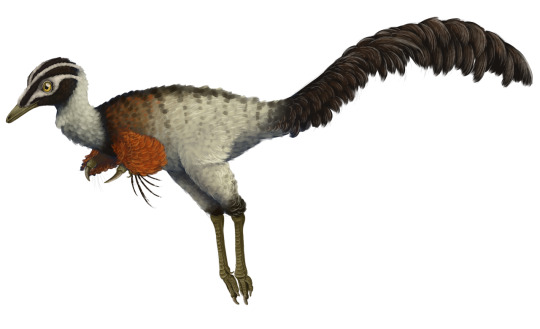
By Scott Reid
Other: Nemegtonykus was found alongside a specimen of Mononykus, potentially indicating that different Alvarezsaurs potentially socialized with each other, or at least didn’t avoid each other within their shared habitats. This may also indicate a level of niche partitioning between different Alvarezsaurs.
~ By Meig Dickson
Sources Under the Cut
Arbour, V. M., Currie, P. J. and Badamgarav, D. (2014), The ankylosaurid dinosaurs of the Upper Cretaceous Baruungoyot and Nemegt formations of Mongolia. Zoological Journal of the Linnean Society, 172: 631–652.
Barsbold, R. (1983). “Carnivorous dinosaurs from the Cretaceous of Mongolia [in Russian].” Trudy, Sovmestnaâ Sovetsko−Mongol’skaâ paleontologičeskaâ èkspediciâ, 19: 1–120.
Chinzorig, T., Kobayashi, Y., Tsogtbaatar, K., Currie, P.J., Takasaki, R., Tanaka, T., Iijima, M., Barsbold, R. 2017. Ornithomimosaurs from the Nemegt Formation of Mongolia: manus morphological variation and diversity. Palaeogeography, Palaeoclimatology, Palaeoecology 494: 91 - 100.
Choiniere, J.N.; Xu, X.; Clark, J.M.; Forster, C.A.; Guo, Y.; Han, F. (2010). "A basal alvarezsauroid theropod from the early Late Jurassic of Xinjiang, China". Science. 327 (5965): 571–574.
Fanti, F., Bell, P.R., Tighe, M., Milan, L.A., Dinelli, E. 2017. Geochemical fingerprinting as a tool for repatriating poached dinoaur fossils in Mongolia: A case study for the Nemegt Locality, Gobi Desert. Palaeogeography, Palaeoclimatology, Palaeoecology 494: 51 - 64.
Fowler DW, Woodward HN, Freedman EA, Larson PL, Horner JR (2011) Reanalysis of “Raptorex kriegsteini”: A Juvenile Tyrannosaurid Dinosaur from Mongolia. PLoS ONE 6(6): e21376.
Funston, G. F.; Mendonca, S. E.; Currie, P. J.; Barsbold, R. (2017). “Oviraptorosaur anatomy, diversity and ecology in the Nemegt Basin”. Palaeogeography, Palaeoclimatology, Palaeoecology.
Gradzinski, R., J. Kazmierczak, J. Lefeld. 1968. Geographical and geological data form the Polish-Mongolian Palaeontological Expeditions. Palaeontologia Polonica 198: 33 - 82.
Holtz, Thomas R., Jr. (2007). "Ornithomimosaurs and Alvarezsaurs". Dinosaurs: The Most Complete, Up-to-Date Encyclopedia for Dinosaur Lovers of All Ages.
Holtz, T.R. 2014. Paleontology: Mystery of the horrible hands solved. Nature 515 (7526): 203 - 205.
Hurum, J. 2001. Lower jaw of Gallimimus bullatus. In Tanke, D. H., K. Carpenter, M. W. Skrepnick. Mesozoic Vertebrate Life. Bloomington: Indiana University Press. 34 - 41.
Jerzykiewicz, T., Russell, D.A. 1991. Late Mesozoic stratigraphy and vertebrates of the Gobi Basin. Cretaceous Reserch 12 (4): 346 - 377.
Kielan-Jaworowska, Z. 1969. Fossils from the Gobi desert. Science Journal 5(1):32-38.
Kielan-Jaworowska, Z., R. Barsbold. 1972. Narrative of the Polish-Mongolian Palaeontological Expeditions 1967-1971. Palaeontologia Polonica 27: 5 - 136.
Kobayashi, Y., Barsbold, R. 2006. Ornithomimids from the Nemegt Formation of Mongolia. Journal of the Paleontological Society of Korea 22 (1): 195 - 207.
Lee, Y.N., Barsbold, R., Currie, P.J., Kobayashi, Y., Lee, H.J. 2013. New specimens of Deinocherus mirificus from the Late Cretaceous of Mongolia. Society of Vertebrate Paleontology Abstracts of Papers: 161.
Lee, Y.N., Barsbold, R., Currie, P.J., Kobayashi, Y., Lee, H.J., Godefroit, P., Escuillie, F.O., Chinzorig, T. 2014. Resolving the long-standing enigmas of a giant ornithomimosaur Deinocheirus mirificus. Nature 515 (7526): 257 - 260.
Lee, S., J.-Y. Park, Y.-N. Lee, S.-H. Kim, J. Lü, R. Barsbold, K. Tsogtbaatar. 2019. A New Alvarezsaurid Dinosaur from the Nemegt Formation of Mongolia. Scientific Reports 9: 15493.
Lü, JC; Xu, L; Chang, HL; Jia, SH; Zhang, JM; Gao, DS; Zhang, YY; Zhang, CJ; Ding, F (2018). "A new alvarezsaurid dinosaur from the Late Cretaceous Qiupa Formation of Luanchuan, Henan Province, central China". China Geology. 1: 28–35.
Newbrey, M. G., Donald B. Brinkman, Dale A. Winkler, Elizabeth A. Freedman, Andrew G. Neuman, Denver W. Fowler and Holly N. Woodward (2013). “Teleost centrum and jaw elements from the Upper Cretaceous Nemegt Formation (Campanian-Maastrichtian) of Mongolia and a re-identification of the fish centrum found with the theropod Raptorex kreigsteini”. In Gloria Arratia; Hans-Peter Schultze; Mark V. H. Wilson (eds.). Mesozoic Fishes 5 – Global Diversity and Evolution. Verlag Dr. Friedrich Pfeil. pp. 291–303.
Schweitzer, Mary Higby, Watt, J.A., Avci, R., Knapp, L., Chiappe, L, Norell, Mark A., Marshall, M. (1999). "Beta-Keratin Specific Immunological reactivity in Feather-Like Structures of the Cretaceous Alvarezsaurid, Shuvuuia deserti Journal of Experimental Biology (Mol Dev Evol) 255:146-157.
Shuvalov, V.F. (2000). “The Cretaceous stratigraphy and palaeobiogeography of Mongolia”. In Benton, Michael J.; Shishkin, Mikhail A.; Unwin, D.M.; Kurochkin, E.N. (eds.). The Age of Dinosaurs in Russia and Mongolia. Cambridge University Press. pp. 256–278.
Takanobu Tsuihiji, Brian Andres, Patrick M. O'connor, Mahito Watabe, Khishigjav Tsogtbaatar & Buuvei Mainbayar (2017) Gigantic pterosaurian remains from the Upper Cretaceous of Mongolia, Journal of Vertebrate Paleontology.
Turner, Alan H.; Pol, Diego; Clarke, Julia A; Erickson, Gregory M.; Norell, Mark (2007). "A basal dromaeosaurid and size evolution preceding avian flight". Science. 317 (5843): 1378–1381.
Watabe, M., S. Suzuki, K. Tsogtbaatar, T. Tsubamoto, M. Saneyoshi. 2010. Report of the HMNS-MPC Joint Paleontological Expedition in 2006. Hayashibara Museum of Natural Sciences Reasearch Bulletin 3:11 - 18.
Watanabe, A., Eugenia Leone Gold, M., Brusatte, S.L., Benson, R.B.J., Choiniere, J., Davidson, A., Norell, M.A., Claessens, L. 2015. Vertebral pneumaticity in the ornithomimosaur Archaeornithomimus (Dinosauria: Theropoda) revealed by computed tomography imaging and reappraisal of axial pneumaticity in ornithomimosuria. PLoS ONE 10 (12): e0145168.
Zelenitsky, D K., F. Therrien, G. M. Erickson, C. L. DeBuhr, Y. Kobayashi, D. A. Eberth, F. Hadfield. 2012. Feathered non-avian dinosaurs from North America provide insight into wing origins. Science 338 (6106): 510 - 514.
#Nemegtonykus#Nemegtonykus citus#Alvarezsaur#Dinosaur#Palaeoblr#Prehistoric Life#prehistory#paleontology#Factfile#Cretaceous#Eurasia#Omnivore#Theropod Thursday#Maniraptoran#dinosaurs#biology#a dinosaur a day#a-dinosaur-a-day#dinosaur of the day#dinosaur-of-the-day#science#nature
237 notes
·
View notes